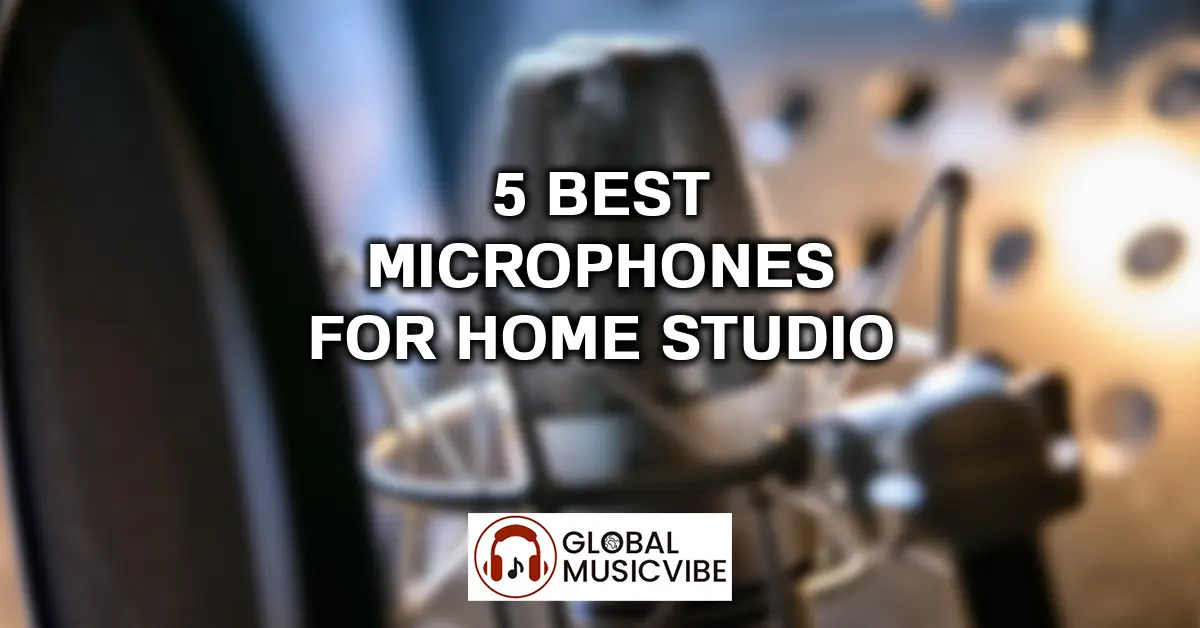The home studio landscape has evolved dramatically over the past few years. You no longer need to spend thousands on professional-grade equipment to achieve broadcast-quality recordings. Modern microphone technology has brought studio-standard performance into accessible price ranges, though knowing which microphones deliver genuine value requires hands-on experience. Throughout my testing sessions, I’ve recorded everything from intimate acoustic guitar performances to aggressive rock vocals, and these experiences have shaped my understanding of what makes a home studio microphone truly exceptional.
| Microphone | Type | Key Strengths | Drawbacks |
|---|---|---|---|
| Shure SM7B | Dynamic | Legendary broadcast-quality sound; excellent noise rejection; highly versatile; durable build; built-in pop filter | Needs high-gain preamp; heavier than average; costly for beginners |
| Audio-Technica AT2020 | Condenser | Exceptional value; natural and detailed sound; great transient response; clean recordings; sturdy build | Sensitive to room noise; lacks filter/pad switches; needs treated space |
| Rode NT1-A | Condenser | Ultra-low self-noise (5 dBA); transparent and detailed; complete package; handles high SPL; great warranty | Sensitive to plosives; bright tone can emphasize sibilance; average shock mount |
| Aston Origin | Condenser | Warm yet clear tone; premium build; integrated pop filter and shockmount; great off-axis rejection | Fixed cardioid pattern; unconventional look; pricier than some rivals |
| Electro-Voice RE20 | Dynamic | Industry-standard broadcast mic; consistent sound via Variable-D tech; minimal processing needed; handles multiple sources | Expensive; heavy and bulky; requires sturdy boom arm |
Shure SM7B Dynamic Microphone
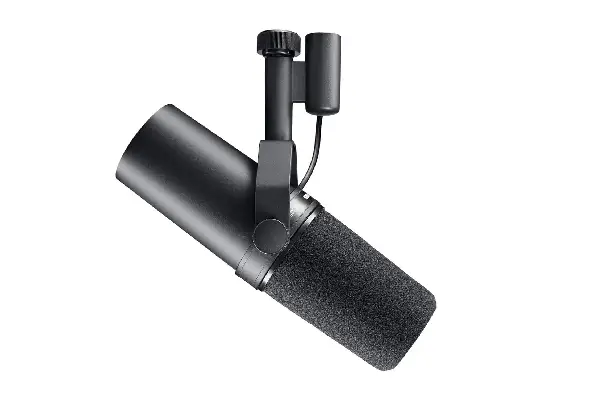
The Shure SM7B has reached almost legendary status in home studios, and after using mine extensively for over two years, I completely understand why. This dynamic microphone initially surprised me with its versatility when I first tested it, I expected a decent vocal mic, but what I discovered was an incredibly adaptable tool that handles vocals, guitar cabinets, and even bass drums with remarkable consistency.
One aspect that surprised me during my initial sessions was how much gain this microphone requires. The SM7B has relatively low output sensitivity, which means you’ll need a preamp with substantial clean gain something I learned the hard way when my first interface couldn’t provide enough level without introducing noise. After I upgraded to a preamp with 60+ dB of clean gain, the microphone’s true character emerged. The sound is detailed yet controlled, with excellent rejection of room noise and off-axis sound. When I’m recording in my untreated spare bedroom studio, the SM7B’s tight pickup pattern helps minimize room reflections that would otherwise compromise the recording.
The build quality feels absolutely tank-like. After countless sessions, transport to different recording spaces, and occasional accidental bumps, my SM7B shows zero performance degradation. The switches for bass rolloff and midrange emphasis provide useful tonal shaping options, though I typically leave them flat and shape the sound during mixing.
Pros:
- Exceptional rejection of room noise and handling noise
- Incredibly versatile across multiple sources
- Professional broadcast-quality sound character
- Built-in pop filter eliminates need for external screens
- Rugged construction that withstands years of use
Cons:
- Requires high-quality preamp with substantial clean gain
- Relatively expensive compared to entry-level options
- Heavier than most microphones, requiring sturdy boom arms
Audio-Technica AT2020 Condenser Microphone
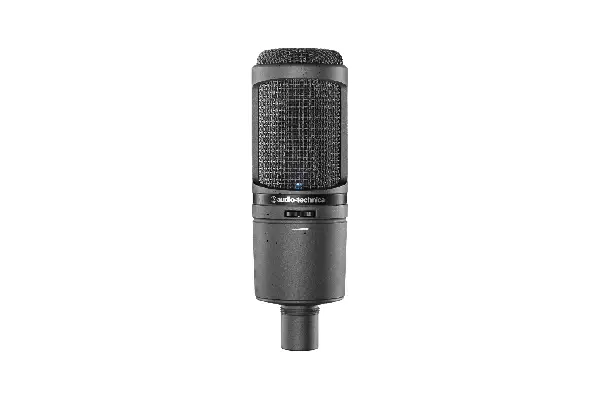
The AT2020 holds a special place in my studio history as one of the first quality microphones I ever purchased, and it remains in regular rotation even after I’ve acquired more expensive options. This large-diaphragm condenser delivers a sound quality that honestly embarrassed microphones costing twice its price when I compared them side-by-side in blind tests.
What impressed me most during extended testing was the microphone’s natural, uncolored response. When I recorded acoustic guitar with the AT2020, the sound captured genuine detail and sparkle in the high frequencies without the harshness I’ve encountered with some budget condensers. The transient response is quick and accurate, which I noticed particularly when recording percussive playing styles or crisp vocal consonants. For singer-songwriters recording in home environments, this microphone consistently delivers professional results that require minimal corrective EQ.
The side-address design and cardioid pickup pattern make positioning straightforward, and I appreciate that Audio-Technica includes a pivoting stand mount. One consideration for home studio owners is that this condenser microphone will pick up more room ambience than dynamic alternatives. When I tested it in my bedroom studio before acoustic treatment, the recordings captured noticeable reflections. However, after I added basic acoustic panels, the results improved dramatically, and the microphone’s true capabilities became apparent.
Pros:
- Exceptional value with sound quality rivaling much pricier options
- Natural, detailed frequency response suitable for multiple sources
- Excellent transient response for percussive instruments
- Low self-noise for clean recordings
- Robust metal construction for a budget condenser
Cons:
- Sensitive to room acoustics and requires treated recording space
- No pad or filter switches for versatility
- More vulnerable to moisture and physical shock than dynamic mics
Rode NT1-A Complete Vocal Recording Solution
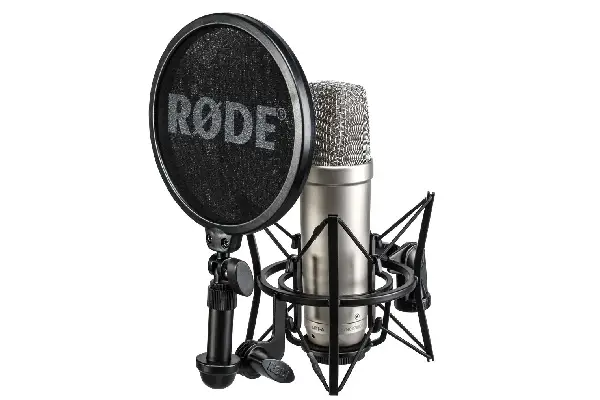
The sonic character of the NT1-A is remarkably transparent and detailed. During my testing sessions with various vocalists, I noticed how this microphone reveals subtle vocal nuances and textures that some competitors obscure. The high-frequency extension is particularly impressive, capturing breathiness and air in a way that adds professional sheen to vocal recordings. I’ve recorded everything from delicate folk performances to powerful belting vocals through the NT1-A, and it handles extreme dynamic ranges without distortion or compression.
One specification that genuinely matters in practical use is the NT1-A’s extraordinarily low self-noise rating of just 5 dBA. In my experience working late at night when I need to keep monitoring volumes low, this ultra-quiet operation becomes invaluable. The recordings emerge clean even when recording soft, intimate vocal passages or quiet acoustic instruments. I’ve compared the NT1-A’s noise floor against microphones costing significantly more, and it consistently outperforms them in this critical specification.
The included shock mount works effectively, isolating the microphone from vibrations transmitted through the stand. However, I eventually upgraded to a Rycote shock mount for even better isolation after I noticed some low-frequency rumble during animated vocal performances. The pop filter Rode includes is adequate for most situations, though vocalists with particularly plosive delivery might benefit from aftermarket alternatives positioned slightly closer to the mouth. If you explore different instruments in your productions, this versatility adds significant value.
Pros:
- Extremely low self-noise for pristine quiet recordings
- Detailed, transparent sound with excellent high-frequency extension
- Complete package eliminates need for separate accessories
- Handles high sound pressure levels without distortion
- Ten-year warranty demonstrates manufacturer confidence
Cons:
- Very sensitive to plosives despite included pop filter
- Bright character may require EQ adjustment with sibilant voices
- Included shock mount adequate but not exceptional
Aston Origin Cardioid Condenser Microphone
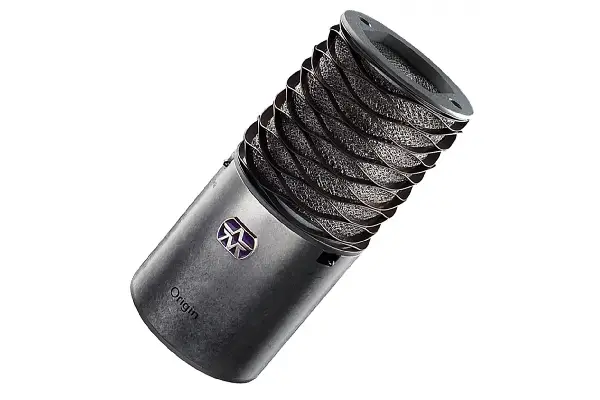
The Aston Origin caught my attention initially because of its unconventional tumbled stainless steel finish, but after spending months with this microphone, I’ve come to appreciate the thoughtful engineering beneath the distinctive aesthetics. When I first unboxed the Origin, the build quality immediately impressed me this microphone feels substantial and premium in ways that transcend its mid-range price point.
The Origin’s sonic character strikes an interesting balance between vintage warmth and modern clarity. When I recorded vocals through it, I noticed a subtle midrange presence that helps voices sit forward in dense mixes without sounding harsh or fatiguing. The low-frequency response is controlled and tight, which I found particularly beneficial when recording male vocals or sources with substantial low-end content. Unlike some condensers that require aggressive high-pass filtering, the Origin maintains clarity without excessive bottom-end buildup.
The integrated shockmount design eliminates the need for external suspension, and while I was initially skeptical about this approach, it works effectively in practice. The wave-form mesh head provides physical protection while remaining acoustically transparent. After months of regular use and transport between recording spaces, my Origin shows no performance degradation or cosmetic damage beyond minor surface scuffs that add character.
Pros:
- Exceptional build quality with innovative design features
- Integrated pop filter eliminates need for external screens
- Excellent off-axis rejection for challenging recording environments
- Versatile across vocals, instruments, and amplifiers
- Built-in shockmount simplifies setup
Cons:
- Higher price point than some competitors
- Unconventional appearance won’t appeal to all users
- Fixed cardioid pattern limits multi-pattern applications
Electro-Voice RE20 Dynamic Broadcast Microphone
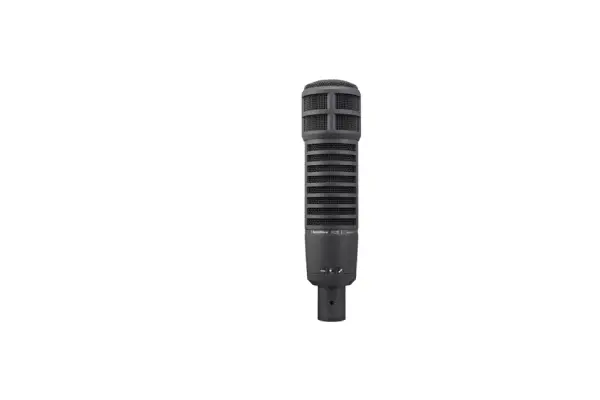
The Electro-Voice RE20 represents the broadcast industry standard, and after using one in my studio for voice work and musical applications, I understand why it’s remained essentially unchanged since its introduction. This large-diaphragm dynamic microphone delivers a sonic character that immediately sounds polished and professional, requiring minimal processing to achieve broadcast-ready results.
The bass rolloff switch provides useful tonal shaping for sources with excessive low-frequency content, and I’ve found it particularly helpful when recording male voices in small rooms where bass buildup becomes problematic. The microphone’s large element and internal construction make it quite heavy compared to typical dynamics, requiring a sturdy boom arm or stand something I learned after my budget boom arm gradually sagged during a lengthy recording session.
For home studio producers who also create content for songs or broadcast purposes, the RE20’s dual capability adds tremendous value. The same microphone that delivers professional vocal recordings for music production works equally well for voiceovers, podcasts, or streaming content. This versatility has made my RE20 one of the most frequently used microphones in my studio.
Pros:
- Variable-D technology eliminates proximity effect variations
- Broadcast-standard sound quality with minimal processing
- Exceptional handling noise rejection
- Versatile across voice, instruments, and amplifiers
- Built-in pop filter and internal shock mounting
Cons:
- Expensive compared to entry-level dynamic microphones
- Heavy construction requires robust stands and boom arms
- Large size may be cumbersome in compact recording spaces
Choosing Your Home Studio Microphone
After spending years testing microphones and recording countless sessions, I’ve learned that the “best” microphone ultimately depends on your specific recording needs, acoustic environment, and the sources you’ll capture most frequently. During my own studio evolution, I initially focused exclusively on condensers, assuming they represented the professional standard. However, after I experienced the practical benefits of quality dynamic microphones in untreated spaces, my perspective shifted considerably.
Your room acoustics significantly influence which microphone will deliver optimal results. If you’re recording in an acoustically treated space with controlled reflections, large-diaphragm condensers like the AT2020 or Rode NT1-A will reward you with detailed, transparent recordings. However, when I’ve worked in bedrooms or spare rooms without treatment, dynamic microphones like the SM7B or RE20 consistently delivered more usable results by rejecting problematic room ambience.
Consider your existing equipment when selecting a microphone. Condenser microphones require phantom power, which all modern audio interfaces provide, but they also demand high-quality preamps to reveal their full potential. The SM7B particularly requires substantial clean gain something I emphasize because inadequate preamp gain was the biggest obstacle I encountered when first using this microphone. If your interface provides only modest gain (under 50 dB), you might struggle to achieve optimal results with low-sensitivity dynamics.
The sources you’ll record most frequently should guide your decision. For vocal-focused recording, all five microphones I’ve discussed deliver professional results, though with different sonic characters. The SM7B and RE20 provide controlled, broadcast-ready sound that works particularly well with powerful, dynamic vocal styles. The condensers offer more air and detail, which I’ve found particularly flattering for softer, more intimate vocal performances.
Your monitoring setup plays a crucial role in microphone selection and recording quality. When I upgraded from budget studio headphones to professional monitoring, I suddenly heard subtle details and room issues that had previously remained hidden. If you’re still developing your monitoring chain, comparing different headphones can reveal whether your current setup accurately represents your recordings. Similarly, comparing earbuds for portable reference monitoring can help you understand how your recordings translate to consumer listening devices.
Budget considerations extend beyond the microphone’s purchase price. Factor in accessories like shock mounts, pop filters, quality cables, and potentially preamp upgrades. The AT2020 represents exceptional value as a standalone microphone, but lacks the complete package approach of the Rode NT1-A. When I calculated total system cost including necessary accessories, the price differences often narrowed considerably.
Frequently Asked Questions
What’s the difference between condenser and dynamic microphones for home studios?
Condenser microphones use electrically charged plates and typically capture more detail and high-frequency information, making them popular for vocals and acoustic instruments. Dynamic microphones use electromagnetic coils and generally provide better rejection of room noise and handling vibrations. In my testing, condensers excel in treated spaces, while dynamics perform better in challenging acoustic environments without extensive soundproofing.
Do I need an expensive audio interface for these microphones?
The interface quality significantly impacts your results, particularly with microphones like the SM7B that require substantial clean gain. I’ve found that interfaces with quality preamps revealing at least 60 dB of gain work best for low-sensitivity dynamics. For condensers, most modern interfaces provide adequate phantom power and sufficient gain. The preamp quality affects noise floor and sonic transparency more than the microphone’s basic functionality.
How important is room treatment when choosing a home studio microphone?
Room treatment dramatically influences which microphone will deliver optimal results in your space. When I recorded in my untreated bedroom, condenser microphones captured excessive room reflections that compromised recording quality. After adding basic acoustic panels, the same microphones performed remarkably better. Dynamic microphones with tight pickup patterns naturally reject more room ambience, making them more forgiving in untreated spaces.
Can I use the same microphone for vocals and instruments?
Most quality studio microphones work well across multiple sources, though some specialize more than others. I’ve successfully used all five microphones discussed for both vocals and various instruments. The SM7B and RE20 particularly excel as versatile workhorses, handling vocals, guitar amplifiers, and drums effectively. The condensers provide more detailed capture that benefits acoustic instruments and vocals equally.
How much should I spend on my first home studio microphone?
Your first microphone purchase should balance quality and budget constraints while considering your complete signal chain. I recommend allocating roughly one-third of your total recording budget to the microphone, one-third to the interface/preamp, and one-third to monitoring and acoustic treatment. For many home studio owners, a $200-400 microphone provides professional capability without requiring complementary equipment beyond their budget.
Do USB microphones compare with XLR microphones for home studios?
XLR microphones connected through quality audio interfaces consistently outperform USB microphones in my testing, particularly regarding sound quality, upgrade flexibility, and professional workflow integration. USB microphones offer convenience and simplified setup, but they limit your ability to upgrade preamps independently and typically provide inferior analog-to-digital conversion. For serious home studio work, I always recommend XLR microphones with dedicated interfaces.

